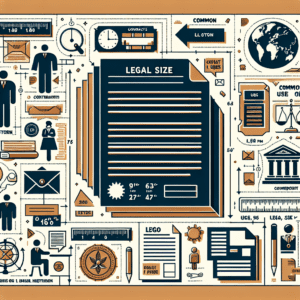===INTRO:===
Understanding legal size is crucial for anyone involved in documentation, printing, or legal proceedings. Legal size paper, measuring 8.5 x 14 inches, often presents challenges and confusion, especially for those accustomed to standard letter size. Many individuals and organizations underestimate the significance of these dimensions and their specific applications, leading to inefficiencies and frustrations. This comprehensive guide delves into the dimensions of legal size and its multifaceted applications across various industries, ensuring you have the insights necessary to navigate this essential aspect of document handling effectively.
Decoding Legal Size: Key Dimensions and Their Significance
Legal size paper is defined by its unique dimensions of 8.5 inches in width and 14 inches in height. This specific size was created to accommodate additional content, such as lengthy legal documents, contracts, and agreements, that often require more space than the conventional letter size (8.5 x 11 inches) provides. Understanding these measurements is essential, as they directly impact how documents are formatted, printed, and ultimately processed. When dealing with legal documents, size determines not just fit, but also readability and compliance with industry standards.
The significance of legal size extends beyond mere dimensions; it influences the workflows of legal professionals, administrative staff, and business operations. Legal size documents are often utilized in law offices, courts, and real estate transactions, where comprehensive information must be conveyed clearly and professionally. The choice of paper size can affect how a document is received by its audience, with legal size often being associated with professionalism and attention to detail. This perception can be vital in cases where the presentation may sway opinions or affect outcomes.
Moreover, the legal size format can also intersect with digital workflows. As more organizations transition to electronic documentation, understanding the historical context and practical usage of legal size becomes vital. Many legal software platforms allow for the seamless integration of legal size documents, ensuring that they remain easily accessible and correctly formatted for electronic filing and sharing. By grasping the nuances of legal size dimensions, professionals can enhance their operational efficiency and maintain a competitive edge in their respective fields.
Practical Applications of Legal Size in Various Industries
Legal size paper finds its primary application in the legal industry, where documents such as contracts, pleadings, and affidavits are commonly formatted to this size. Legal professionals often prefer this format for its ability to accommodate extensive text while preserving clarity and legibility. With the rise of electronic document storage, legal size files are often scanned and stored digitally, requiring meticulous attention to detail regarding their dimensions to ensure that they maintain their integrity in both physical and digital formats.
Beyond the legal sphere, many businesses leverage legal size paper for human resources documentation, including employee contracts, onboarding materials, and policy manuals. The extra space allows organizations to include comprehensive information without the need for additional pages that could complicate document management. This practice not only streamlines the onboarding process but also enhances communication within the company, ensuring that employees receive all necessary information upfront.
In the real estate sector, legal size documents serve similarly crucial purposes. Purchase agreements, disclosures, and closing documents often require detailed explanations and clauses, making legal size the preferred format. By utilizing this size, real estate professionals can present information clearly, reducing the risk of misunderstandings that could lead to disputes. Furthermore, the continued use of legal size in these contexts not only maintains consistency across documents but also reinforces the professionalism expected in high-stakes transactions.
===OUTRO:===
Understanding the dimensions and applications of legal size is an essential skill for professionals across various industries. Whether you are in law, business, or real estate, leveraging legal size paper effectively can enhance your operational efficiency and reinforce a professional image. With this knowledge, you can navigate the complexities of documentation with confidence, ensuring that your materials not only meet industry standards but also facilitate clear communication. If you’re ready to elevate your document management strategies and embrace the full potential of legal size, consider diving deeper into the resources and tools available to you. Your next successful document could be just a page away.
Understanding Legal Self-Defense Weapons in CanadaUnderstanding Legal Paper Size: Dimensions and Uses ExplainedNavigating Legal Name Changes in Ontario: A Comprehensive GuideRelevant LinkRelevant LinkRelevant Link



















